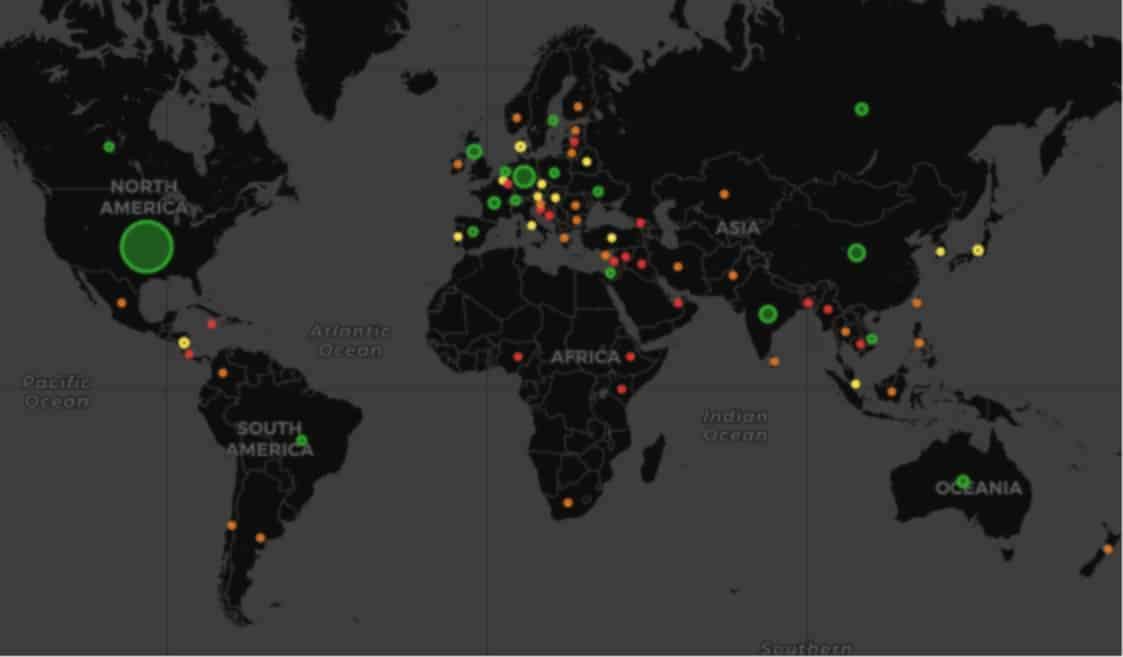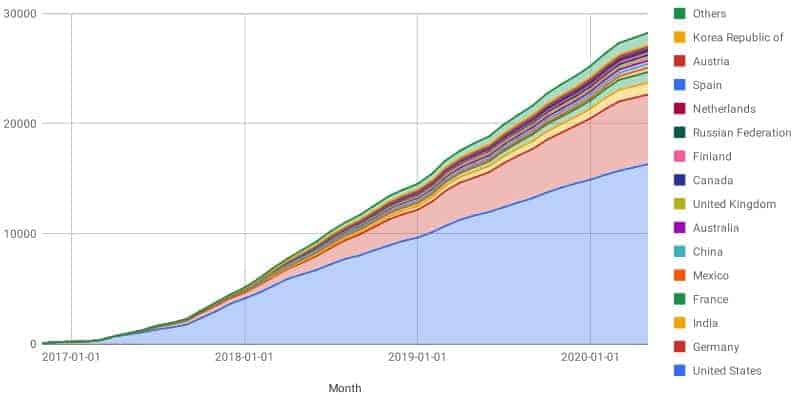Jaeger is an open source, end-to-end distributed tracing platform built to help companies of all sizes monitor and troubleshoot their cloud native architectures.
Created in 2015 by Uber, Jaeger is now integrated into thousands of microservices and records thousands of traces every second across the company. In October 2019, Jaeger hit graduated status within CNCF, joining the ranks of Helm, Fluentd, containerd, and others.
This report assesses the state of the Jaeger project and how CNCF has impacted its progress and growth. Without access to a multiverse to play out alternative scenarios, it is impossible to sort out causation. However, we can document correlations. This report is part of a series of project journey reports published by CNCF focused on graduated projects.
Project Snapshot
Jaeger’s first commit was on August 3, 2015 in the internal repository at Uber. Jaeger’s first public commit on GitHub was made on April 20, 2016. Between joining CNCF on September 13, 2017, and today, Jaeger has added:
Note: These statistics were collected with the DevStats tool, which CNCF built in collaboration with CNCF project communities. “Contributor” is defined as somebody who made a review, comment, commit, or created PR or issue.
CNCF Premise of Open Source Software Development
A basic premise behind CNCF conferences, including KubeCon + CloudNativeCon, and open source in general, is that most interactions are positive-sum. There is no fixed amount of investment, mindshare, or development contributions allocated to specific projects.
Just as open source development is based on the idea that, collectively, we are smarter together than any one of us alone, open source foundations work to make the entire community better. Equally important, a neutral home for a project and community fosters this type of positive-sum thinking, and drives growth and diversity that we believe are core elements of a successful open source project.
Code Diversity
From its roots at Uber, the Jaeger project has grown to incorporate meaningful code contributions from more than 300 organizations. High-velocity open source projects like Jaeger garner wide adoption and contribution from both vendor and end user communities.
As such, Jaeger code contributions come from a wide range of companies, fostering user-driven innovation. Contributors to Jaeger include many of the world’s largest tech companies, such as Uber, Red Hat, Ryanair, IBM, and Ticketmaster as well as fast-growing mid-size companies like Cloudbees. Contributions also come from dozens of small businesses and startups, such as Grafana Labs.
The diversity of vendor contributors is also expanding; Ryanair has grown to become the third-largest contributor to Jaeger since project inception. Contributing organizations to Jaeger are well distributed between vendors and end users, demonstrating that end user innovation can foster and sustain fast-growing, successful projects.
Diversity Across Company Size and Type (End User, Vendor, Foundation) By the Numbers
The top two contributing companies to Jaeger as of the end of the April 2020 reporting period were Uber and Red Hat, with 47% and 38% of contributions, respectively. Uber and Red Hat provided the majority of initial code contributions to the project over the first two years, but the Jaeger project has diversified to include many additional companies.
The total number of companies contributing code has increased by 917% since Jaeger joined CNCF, from 29 to 295. As Uber’s percentage of all contributions has decreased, the company has continued to contribute a high volume of code even as Red Hat, Ryanair, and Transit have dramatically expanded their contributions.
This indicates a healthy dynamic in which the project originators continue to contribute high volumes of code but encourage other organizations to contribute a greater percentage of code over time, sharing stewardship and growing the community. Another key project health indicator is the number of contributors. Jaeger has enjoyed 603% expansion of individual contributors over the three years since the project joined CNCF. During the year before joining CNCF, Jaeger accumulated 239 contributors. In the three years since, Jaeger has added 1,682 contributors.
Geographic Diversity of Contributors
Contributors to Jaeger have come from more than two dozen countries spread across five continents.

The geographic diversity of contributions expanded quickly from 1 country in the first year of the project to 5 during the second year. The chart shows the percentage of contributors over time, broken down by country (based on self-reported location on GitHub).

Development Velocity
Among the top projects in terms of velocity, Jaeger is flourishing.
One way we track developer velocity is with the following formula: velocity = commits + PRs + issues + authors.
We also look at the growth of PRs, code commits, and issues filed as separate line charts.
A third way to examine velocity is by looking at the cumulative number of contributors over time. The charts below illustrate sharply rising velocity for Jaeger.
Jaeger Commits, PRs, and Issues
Education, Events and Sponsorship
Growth of community participation in education, events, and sponsorship is a reliable proxy for the health of a project.

The Jaeger project actively participates in KubeCon + CloudNativeCon North America, China, and Europe through a variety of presentations and talks from community leaders.
In 2019, the project hosted 13 presentations across all CNCF flagship events.
Marketing Growth and Programs
When Jaeger joined CNCF in September 2017, the foundation started promotional efforts to help sustain, nurture, and expand the Jaeger community.
This includes blog posts, email newsletter mentions, and social media support. Thanks in part to these marketing efforts, public awareness of and interest in Jaeger have grown quickly. Google Analytics data for Jaeger shows an increase in pageviews since the project was contributed to CNCF, totaling more than 863K to date.
The project has over 4k followers on Twitter, having increased its following since joining CNCF.

Project Documentation
Continuous additions to and improvements of project documentation are essential for the growth of any open source project.
Robust documentation is critical to educating new users and to helping existing users resolve problems and understand a project’s capabilities. Jaeger documentation has significantly increased over the years. Since joining CNCF, the number of authors and companies committing documentation to Jaeger has grown by 496% and 415%, respectively.
As of this report, 67 authors have committed, and 155 companies are involved in committing documentation. The number of documentation commits has increased by 382% since Jaeger joined CNCF (as of September 2017).
Note: Documentation for Jaeger is authored in .md files. CNCF uses the DevStats tool to automatically collect and count statistics of all relevant .md files in the Jaeger repositories in GitHub.
Conclusion
CNCF is committed to fostering and sustaining an ecosystem of open source, vendor-neutral projects by democratizing state-of-the-art software development and deployment patterns to make technology accessible for everyone.
We hope this report provides a useful portrait of how CNCF is fostering and sustaining the growth of Jaeger.
“Weave Cloud, our Kubernetes automation platform, is made up of over 70 communicating services, so it can be challenging to troubleshoot. We installed Jaeger in production two years ago, and since then it has been invaluable as a tool to visualise performance and system behaviour, helping us to hunt down many errors and performance issues.”
– Bryan Boreham, Distinguished Engineer, Weaveworks
“Red Hat customers are realizing that handling distributed workloads is hard and you need the right people, the right mindset and the right tooling: Jaeger is that tooling that is helping them identify solutions to their problems faster, which translates into a huge satisfaction for their users. The undeniable success of Jaeger is thanks to huge amount of contributors, spending precious hours and discussions and solving problems that no single company could ever achieve and we are blessed to be part of this journey. “
– Mauricio “Maltron” Leal, Product Manager, Red Hat
“We use Jaeger every day at Grafana Labs, and it’s helped us debug some particularly gnarly slow queries in our Prometheus service. We like Jaeger so much we added support for it in Grafana 7.0! Now you can build a slick incident response flow, going from alert, through metrics and logs all the way to a Jaeger trace, and all in a single UI – Grafana.”
– Tom Wilkie, VP Product, Prometheus maintainer, Cortex and Loki author, Grafana Labs